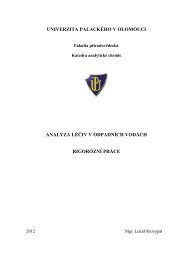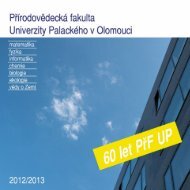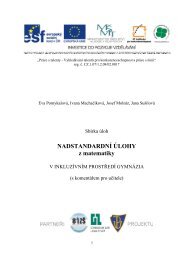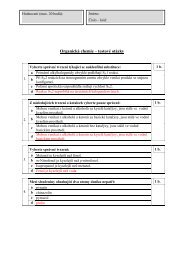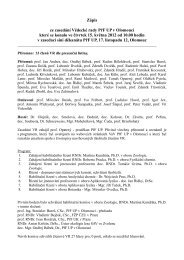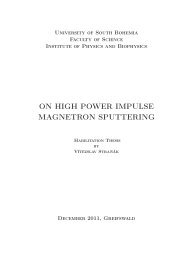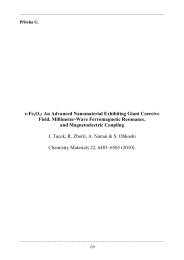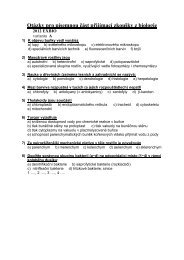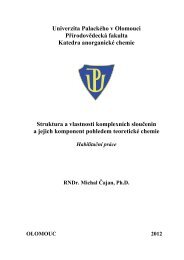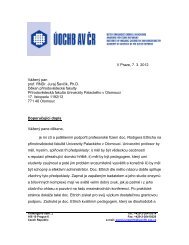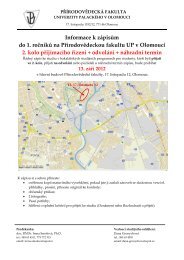A comparative structural analysis of direct and indirect shoot ...
A comparative structural analysis of direct and indirect shoot ...
A comparative structural analysis of direct and indirect shoot ...
You also want an ePaper? Increase the reach of your titles
YUMPU automatically turns print PDFs into web optimized ePapers that Google loves.
E Balus'ka et al.: Mitogen-activated protein kinase SIMK in alfalfa 265<br />
in Fig. 1 K, L), SIMK was seen to have re-entered the<br />
nuclei (Fig. 1 K), but a clear association with the young<br />
cell wall was also apparent (Fig. 1 K). The association<br />
<strong>of</strong> SIMK with young cell walls was consistently found<br />
to extend well into the G1 phase, when cells had clearly<br />
finished cytokinesis, as can be seen by inspecting the<br />
cells in Fig. 1 A, E, <strong>and</strong> I.<br />
Salt-stress-associated changes in intracellular<br />
localization <strong>of</strong> SIMK<br />
A concentration <strong>of</strong> 200 mM NaC1 induces the activation<br />
<strong>of</strong> SIMK in suspension-cultured cells, leaves, <strong>and</strong><br />
roots (Munnik et al. 1999). Root tip cells <strong>of</strong> alfalfa<br />
seedlings that were treated at this salt concentration<br />
for t h showed little changes in the intracellular localization<br />
<strong>of</strong> SIMK. In interphase cells (Fig. 1M, N),<br />
SIMK was found to be still predominantly nuclear.<br />
However, some cells also showed an association <strong>of</strong><br />
SIMK with preprophase b<strong>and</strong>s (Fig. 1M). Whereas<br />
prophase <strong>and</strong> metaphase cells showed a SIMK staining<br />
pattern that was similar to nonstressed cells (data<br />
not shown), some salt-treated root tip cells in telophase<br />
(Fig. 1 O, P) revealed colocalization <strong>of</strong> SIMK<br />
with phragmoplasts (Fig. 1 O). In these cells, SIMK<br />
labeling <strong>of</strong> the newly forming cell walls was distinctly<br />
absent.<br />
Tissue-specific expression <strong>of</strong> SIMK influenced<br />
by salt stress<br />
When root tips were analyzed for SIMK expression at<br />
a lower magnification, it became apparent that SIMK<br />
was abundantly present in most tissues <strong>of</strong> the root<br />
tip (Fig. 2 A). An exception to this rule were the quiescent<br />
center <strong>and</strong> the statocytes at the very root apex<br />
(Fig. 2A) showing much lower amounts <strong>of</strong> SIMK.<br />
Interestingly, root tips <strong>of</strong> salt-stressed seedlings<br />
showed much higher SIMK protein amounts (Fig.<br />
2B). In the transition zone <strong>of</strong> unstressed roots, SIMK<br />
showed considerably higher expression levels in the<br />
epidermis than in the adjacent cortex (Fig. 2C), <strong>and</strong><br />
salt stress exacerbated this difference even further<br />
(Fig. 2 D). When cells <strong>of</strong> the elongation region were<br />
analyzed after salt stress, a large percentage <strong>of</strong> epidermal<br />
cells was observed to have undergone plasmolysis<br />
(Fig. 2E). In these cells, the protoplast<br />
retained most <strong>of</strong> SIMK protein, but some SIMK<br />
protein was also found to be associated with the<br />
plasma membrane <strong>and</strong> the cell wall (Fig. 2 E).<br />
Discussion<br />
In animals, yeasts, <strong>and</strong> plants, specific MAP kinase<br />
pathways are involved in mediating responses to<br />
hyperosmotic stress. The family <strong>of</strong> mammalian MAP<br />
kinases including the SAPK(stress-activated protein<br />
kinase)/JNK(Jun N-terminal kinase)/p38 is activated<br />
by hyperosmotic as well as various other types <strong>of</strong> stress<br />
(Waskiewicz <strong>and</strong> Cooper 1995). In Saccharomyces<br />
cerevisiae, the HOG1 MAP kinase pathway is exclusively<br />
used for mediating hyperosmotic stress (Brewster<br />
et al. 1993). In alfalfa plants, the SIMK pathway is<br />
involved in signaling hyperosmotic stress (Munnik<br />
et al. 1999).<br />
Activation <strong>of</strong> MAP kinases <strong>of</strong>ten involves the<br />
nuclear import <strong>of</strong> the MAP kinase from the cytoplasm<br />
after activation. Studies on the mammalian ERK1/<br />
ERK2 kinases showed that the phosphorylation <strong>of</strong> the<br />
MAP kinase by the upstream MAP kinase kinase was<br />
an essential step to induce the nuclear translocation<br />
(Chen et al. 1992, Lenorm<strong>and</strong> et al. 1993). Recent data<br />
revealed that MAP kinases can shuttle between cytoplasmic<br />
<strong>and</strong> nuclear compartments, <strong>and</strong> that the time<br />
spent in any one compartment can be influenced by a<br />
number <strong>of</strong> parameters that may differ in a systemspecific<br />
way. In mammalian cells, MAPKKs may act as<br />
cytoplasmic anchors for inactive MAPKs (Fukuda<br />
et al. 1997). Phosphorylation <strong>of</strong> MAPK is thought to<br />
induce dissociation from the MAPKK, thereby allowing<br />
nuclear import <strong>of</strong> the MAPK. Other evidence<br />
suggests that phosphorylation-induced dimerization<br />
may also contribute to nuclear import <strong>of</strong> MAPKs<br />
(Khokhlatchev et al. 1998). Investigations <strong>of</strong> the Schizosaccharomyces<br />
pornbe Spcl/Styl stress-signaling<br />
MAP kinase pathway revealed that the nuclear target<br />
<strong>of</strong> the Spcl/Styl kinase, the transcription factor Atfl,<br />
plays an active role in retaining the MAPK in the<br />
nucleus (Gaits et al. 1998). Finally, studies on the<br />
HOG1 kinase in budding yeast added more complexity<br />
by showing that besides regulation <strong>of</strong> entry <strong>and</strong><br />
anchoring <strong>of</strong> the MAPK in the nucleus, nuclear export<br />
<strong>of</strong> the MAPK also contributes to the overall time <strong>of</strong><br />
MAPK nuclear residence (Ferrigno et al. 1998).<br />
To study the intracellular localization <strong>of</strong> SIMK, in<strong>direct</strong><br />
immun<strong>of</strong>luorescence microscopy was performed<br />
on root tip sections <strong>of</strong> seedlings that were either<br />
untreated or stressed with 200 mM NaC1 for different<br />
times. Our <strong>analysis</strong> in nonstressed roots revealed a cell<br />
cycle phase-dependent localization <strong>of</strong> SIMK, showing<br />
constitutive nuclear staining during interphase. The




